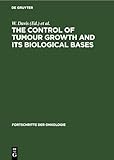The Control of Tumour Growth and its Biological Bases / hrsg. von St. Tanneberger, C. Maltoni, W. Davis.
Material type: TextSeries: Fortschritte der Onkologie ; 10Publisher: Berlin ; Boston : De Gruyter, [2022]Copyright date: 1983Edition: Reprint 2022Description: 1 online resource (468 p.)Content type:
TextSeries: Fortschritte der Onkologie ; 10Publisher: Berlin ; Boston : De Gruyter, [2022]Copyright date: 1983Edition: Reprint 2022Description: 1 online resource (468 p.)Content type: - 9783112611371
- 9783112611388
- 616.9 23
- RC270.8 .D385 1983
- online - DeGruyter
- Issued also in print.
| Item type | Current library | Call number | URL | Status | Notes | Barcode | |
|---|---|---|---|---|---|---|---|
 eBook
eBook
|
Biblioteca "Angelicum" Pont. Univ. S.Tommaso d'Aquino Nuvola online | online - DeGruyter (Browse shelf(Opens below)) | Online access | Not for loan (Accesso limitato) | Accesso per gli utenti autorizzati / Access for authorized users | (dgr)9783112611388 |
Frontmatter -- Contents -- Introduction -- Invasion and Metastasis as Targets for Tumour Therapy -- Primary Invasion: Natural Inhibitors -- Effect of Desacetyl Vinblastine Amide Sulphate or Vindesine (VDS) against the In Vivo Invasion and Formation of Tumour Metastasis -- Invasion and Metastases as Targets for Tumour Therapy. An Overview -- Invasiveness of Brain Tumour Cells In Vivo and In Vitro -- Anti-inyasiveness of Microtubule Inhibitors is due to Interference with the Cytoplasmic Microtubule Complex -- Metastasis: Mitostatic Drugs -- Anticoagulant Treatment of Cancer -- Reactivity of a Monoclonal Antibody (B72.3) with Fixed Sections of Human Mammary Carcinomas -- Polyamine Oxidation in Relation to Tumour Growth and Metastasis -- Partial Purification of an Epidermal Growth Inhibitor (Chalone) -- Hormone. Receptors -- Estradiol Receptor in Human Breast Cancers and Prognosis -- External Quality Assessment Scheme of Estradiol Receptor Assay: An Italian Survey -- Methodological and Clinical Studies of the Steroid Receptor Assay in Primary Breast Cancer -- The Value of Hormone Receptor Assays for Prediction of the Effectiveness of Endocrine Therapy in Breast Cancer -- The Cancer Cell Surface as a Target for Tumour Therapy -- Normal and Pathological Cell Communication -- The Cells Surface as Target for Alkylating Agents -- The Synergistic Effect of Drugs and Antibodies -- Cancerostatic Lectins -- Ribosome-inactivating Proteina as Possible Chemotherapeutic Agents -- Selective Targeting of Ricin A Chain to a Murine B Cell Tumour by Anti-Immunoglobulin Antibodies -- Development of New Drugs -- The Generation of Reactive Molecular Species during the Oxidation of 9-Hydroxyellipticine Derivatives. Interest of Prooxidant Compounds in the Design of Anti-Cancer Drugs. -- Development of Nitroimidazoles -- Development of New Drugs — Immunomodulating Agents -- Development of Potential Clinical Alternatives to Hexamethylmelamine -- Synergistic Interaction of an Alkylating Agent (Lycurim) and an Antimetabolite (Pyrazofurin) on Heptoma 3924A Cells in Culture -- Phase II Evaluation of 4-Thiazolidine-Carboxylic Acid (Thioproline) in Advanced Epidermoid Head and Neck Tumours -- The Effect of a Bifunctional N-Notrosoureido Derivative (GYKI-13324) on Experimental Metastasis Models -- Long-term Toxic and Carcinogenic Effects of Cytostatic Drugs -- VP 16-213 (Etoposide; NSC-141540; Vepesid): A Review -- New Platinum Anti-Cancer Drugs -- The Status of Proteolytic Enzymes in Oncology -- Marcellomycin: A New Class II Anthracycline -- Biological Response Modifiers -- Interferon -- Comparative Interferon-Inducing and Anti-Tumour Activity of Substituted Pyrimidinones -- Influence of Human Leucocyte Interferon on Squamous-Cell Carcinoma of Uterine Cervix: Clinical, Histological and Histochemical Observations -- Effect of Interferon on Malignant Head and Neck Tumours -- Polyamines and Neoplasia: A Review of Present Knowledge of Their Function and Therapeutic Potential -- Retinoids -- The Role of Drug-Induced Differentiation in the Control of Tumour Growth -- Modifying Effect of the Sex Hormonal Environment on the Growth of Basophilic Foci and Hepatocellular Carcinoma -- Phase II Clinical Trial of cis-Dichlorodiammine Platinum (cis-DDP) in Metastatic Brain Tumours — a Preliminary Report -- Adriamycin: Experimental Evidence of Carcinogenicity -- Electroreduction, Mutagenicity and Antimicrobial Activity of 5-Nitroimidazole Derivatives -- Mechanism of the Antileukemic Action of DTIC and its Benzenoid Analog DM-COOK in mice -- Laboratory Assessment of Therapeutic Activity -- The Role of In Vitro Techniques in Assessing Antineoplastic Therapeutic Activities -- In Vivo Tests — Xenografts -- Suitable Models for Long-Term Bioassays on the Therapeutic and Toxic effects of Antiblastic Drugs: Liver Angiosarcomas Produced in Sprague-Dawley Rats by Vinyl Chloride -- Role of some Biological Parameters in Drug Sensitivity and Resistance of Tumour Cells -- Analysis of Cytotoxic and Cytostatic Effects -- An Appraisal of Current In Vivo and In Vitro Screening Methods -- Clinical Relevance of some Useful Methods for In-Vitro Testing of Cytostatic Sensitivity in Cases of Ovarian Cancers -- Immunoglobulin Producing Cell Infiltration in Colorectal Cancer Tissues Correlated with Patients Survival -- Suitable Models for Long-Term Bioassays of Therapeutic and Toxic Effects of Antiblastic Drugs: Brain Tumours of Neuronal Cells and Primitive Bipotential Precursors Produced in Sprague-Dawley Rats by Vinyl Chloride -- Laboratory Assessment of Therapeutic Activity (with Particular Regard to Chemotherapy): Relevant Animal Models -- Biological Significance and Dose-Dependent Effect of 'Resistocell' on Peripheral Blood Leucocytes In Vitro -- Human Serum Ribonuclease Activity as a Marker for Therapeutic Success in Ovarian Carcinoma -- Biological Properties of the New Quinazoline Inhibitor of Thymidylate Synthetase CB 3717 -- Miscellaneous -- Reactivation of Alkylation-Damaged Adenovirus 3 by Cell Cultures Derived from Human Tumours -- Effects of Surgical and Radio-Chemotherapeutic Treatment on the Immunological Pattern in Malignant Glioma Patients -- Control of Megacaryocyte Differentiation in Healthy and Leukemic Patients -- Cytotoxic T Lymphocytes: Various Effects on Human Myeloma Cells -- Analysis of AHH Inducibility Ratios and Distribution in Human Lymphocytes by TLC-Radioisotopic Assay -- Antitumour Actitivy of New Nitrosoureas on Yoshida Sarcoma Ascites Cells In Vivo -- The Mode of Action of Cyclophosphamide -- Index -- Appendix
restricted access online access with authorization star
http://purl.org/coar/access_right/c_16ec
Issued also in print.
Mode of access: Internet via World Wide Web.
In German.
Description based on online resource; title from PDF title page (publisher's Web site, viewed 19. Oct 2024)


